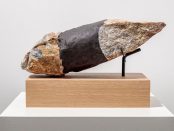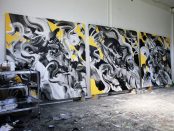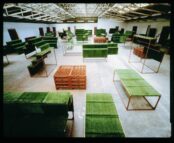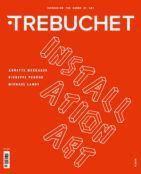[dropcap style=”font-size:100px;color:#992211;”]A[/dropcap]drián Villar Rojas, an Argentinian artist, has displayed his work around the world to great critical acclaim. Ranging widely from vast, improbable creatures and constructions to minuscule, detailed examinations of change and decay, he has created some of the most memorable, unusual pieces in the past two decades.
And yet, his entire ethos is pinned to the idea of impermanence; he deliberately sculpts out of materials such as unfired clay, knowing that his work won’t therefore survive into posterity. For him, this is central to one of the many central ideas he wants to express. In this Phaidon book, Villar Rojas’s background, outlook and key works are explored via interview, a detailed survey, a collection of artists’ notes and a key chronology. As ever with Phaidon, the result is immersive and provides an in-depth glimpse at a unique artist’s creative processes.
In the opening interview with Hans-Ulrich Obrist, Villar Rojas takes us back to his formative years, explaining how at the time his favourite TV characters weren’t always accessible in toy stores, so he and his younger brother set about making their own out of any materials they could access. From plasticine to aircraft kits to paint sets, the brothers would regularly craft and, with the support of their parents, Villar Rojas spent more and more time working artistically, at one point taking over the family home in its entirety for studio space. The interview also begins to explore Villar Rojas’s creative processes, from the meditative, almost automatic process of using clay through to what his art means to him, and what he hopes it could mean to others. His fascination both with halting time, but also noting its passing, is a key idea which underpins much of his artistic approach.
Here, as in Carolyn Christov-Bakargiev’s survey, entitled When It Disappears, the Energy Is Left, the language can be somewhat challenging; granted, these are ideas on a grand scale, so in some respects, this is maybe not the best point of entry for those entirely unfamiliar with his ideals. However, the survey is undoubtedly expansive, with a selection of well-selected images. It also makes mention of a number of other relevant artists whose own ideas chime with Villar Rojas.
Eungie Joo’s focus on the Planetarium installation reiterates many of Villar Rojas’s key ideas on impermanence, process and progress, whilst working together a mini-timeline of prior projects which paved the way. Via the Brick Farm installation in Argentina, we come to his Today We Reboot The Planet and The Theatres of Saturn before, finally, Planetarium in 2015, based this time in a former ice factory in the Gulf of Oman. Finally, there are sections on Villar Rojas’s collaborators, images of his own notepads and a timeline of his key works.
Whilst there’s a certain irony in commemorating Villar Rojas in print given his central ethos, I’m sure he’d point out that the book and all its contributors will be gone and forever forgotten in a hundred years. Until then, this is a meticulous, well realised book, with a good balance of image and text throughout its 160 pages. Adrián Villar Rojas is certainly quite unlike anyone else out there and as such, he deserves to be noted for the work he’s achieved to date.
Adrián Villar Rojas by Carolyn Christov-Bakargiev, Hans-Ulrich Obrist and Eungie Joo, published by Phaidon, is available now at £35
Keri can usually be found contributing to Reprobate Press, where she covers a bit of everything, or writing and editing Warped Perspective, a website which features cult film, TV, art and books.




















